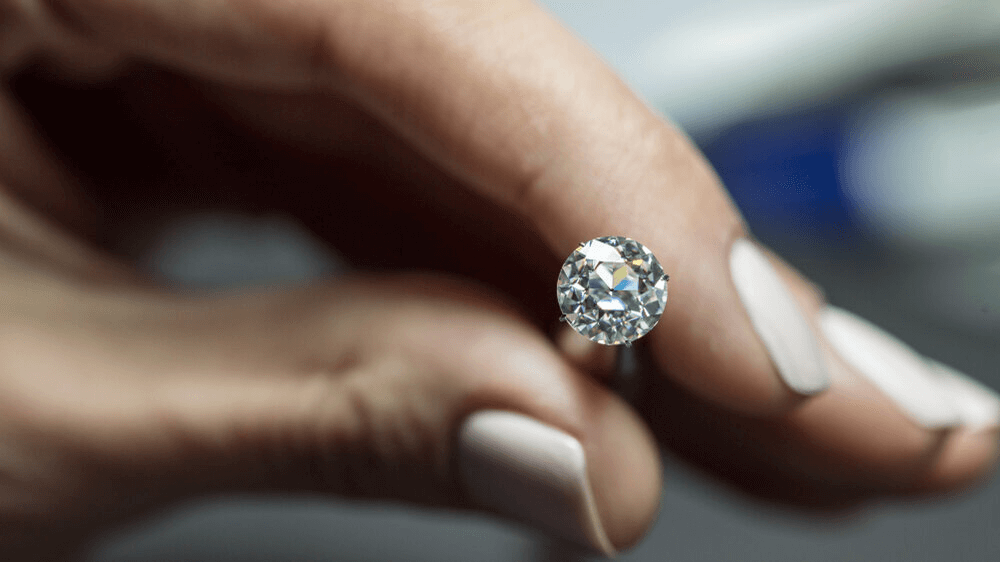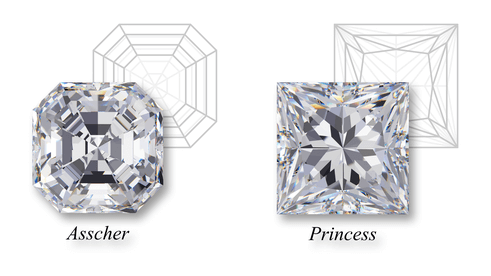Don’t Buy a Radiant Cut Diamond Without This Advice

By Gary A.

Edited by Olivia H.
Published May 10, 2021
Edited on Mar 31, 2025
With its combination of modern brilliance and elegant lines, a radiant cut diamond adds a stunning blend of sparkle and sophistication to any engagement ring, making it a truly unique choice for those seeking timeless beauty.

- 7 Quick Tips for Buying a Radiant Cut Diamond Engagement Ring
- Introduction
- Unique Features of Radiant Cut Diamonds
- Brief History and Appeal
- Radiant Cut vs the Emerald Cut
- Radiant Engagement Rings: Key Factors to Consider
- Radiant Diamond Cost
- Mastering the Art of Choosing a Radiant Cut Diamond
- Radiant Cut Diamond Pros and Cons
- Our Expert Take
- 7 FAQs
Before we dive deeper into the specifics, here are some practical tips to help guide your decision-making process:
7 Quick Tips for Buying a Radiant Cut Diamond Engagement Ring
- Tip 1: Understanding the Radiant Cut’s Unique Appeal
Know the Cut: A radiant cut diamond combines the brilliance of a round cut with the elegance of an emerald cut. Its 70 facets create exceptional sparkle, making it a standout choice for engagement rings. - Tip 2: Examining the Length-to-Width Ratio
Ideal Ratios Matter: The length-to-width ratio greatly impacts the diamond’s appearance. For a traditional rectangular radiant cut, a ratio of 1.25 is standard, though it can vary between 1.05 – 1.50. Square radiant cuts should ideally have a ratio between 1.00-1.05. - Tip 3: Checking for the Bow-Tie Effect
Avoiding Dark Areas: Radiant cut diamonds, especially elongated shapes, can exhibit a ‘bow-tie effect’ – a dark area across the center. While a minor bow tie can add depth, a pronounced one can detract from the diamond’s beauty. Inspect the diamond in various lighting conditions to check for this. - Tip 4: Considering Color and Clarity
Choosing the Right Grade: While radiant cuts can hide some color and inclusions due to their faceting, the choice of color and clarity grade should balance aesthetics and budget. G-H color diamonds and VS1-SI1 clarity grades often offer a good blend of quality and value. - Tip 5: Evaluating the Faceting and Symmetry
Symmetry is Key: The arrangement of facets and overall symmetry contribute to the diamond’s brilliance. Look for a well-proportioned cut that reflects light evenly. Symmetry is crucial in maximizing the radiant cut’s unique sparkle. - Tip 6: Assessing the Setting for the Radiant Cut
Selecting the Right Setting: The setting plays a significant role in enhancing the diamond’s appearance. Popular options include solitaire, halo, and side stone settings. Choose a setting that complements the radiant cut’s shape and maximizes its brilliance. - Tip 7: Pricing and Value
Budget Wisely: Radiant cut diamonds can vary in price depending on their size, cut, color, and clarity. Larger stones will be more expensive. Understanding the factors that influence price will help in making a cost-effective choice without compromising on quality.
Now that you’ve got these practical tips, use Jeweler AI below to find the perfect engagement ring that suits your style and budget:
Introduction
Beyond their brilliance and fire, a large part of the appeal of any diamond is represented by the complex and seemingly endless patterns we see when we stare directly through their tables. In the Emerald, the effect is often likened to a hall of mirrors; in the Princess, the effect is kaleidoscopic and altogether fascinating.
The Radiant cut, however, occupies a special place in collectors’ hearts for the incredible patterns found just beneath its surface. A spectacular combination of the Brilliant and Step cuts, this diamond offers tremendous sparkle and a beguiling appearance that offers a stunning, modern alternative to the more traditional diamond shapes.
But, is it the right choice for you? Read the guide below.
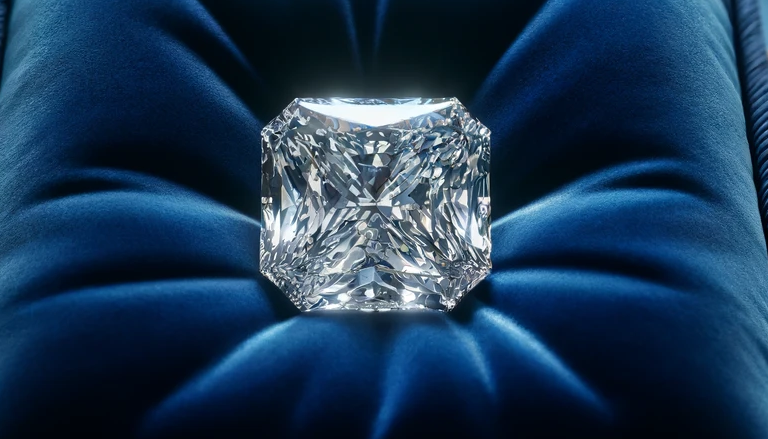
Unique Features of Radiant Cut Diamonds
Square or, less commonly, rectangular in shape, the Radiant combines two of the most contrasting diamond cuts – the Round Brilliant and the Emerald – together to create something utterly spellbinding.
In silhouette, the Radiant cut appears the same as the Emerald. An irregular octagon, the shape features four straight sides creating following square or, less commonly, rectangular dimensions, and four beveled corners (unlike, say, the Princess, which features corners that meet at sharp points).
The facet pattern, however, was designed in the image of the Round Brilliant. This lends the shape incredible levels of fire, brilliance, and scintillation – levels that those who opt for the Emerald cut have to forgo for the sake of the Step Cut facet pattern.
And, while the Radiant is known as a hybrid of these two cuts, the overall effect is something totally unique and arresting. Bright, sparkly, and refined in shape, the Radiant lives up to its name and promises a beautiful center stone for your engagement ring.
Another important feature to note when it comes to the Radiant is the fact that the ideal dimensions for this cut ask for a larger face-up area than many other shapes, including the Round Brilliant. This means that a 1 carat Radiant will look a little larger than a 1 carat diamond featuring a shape that requires more weight in the pavilion.
Brief History and Appeal
The Radiant cut was first designed in 1977 by Henry Grossbard of the Radiant Cut Diamond Company. He invented a hybrid cutting style, revolutionizing the step-cut diamond, and changing the way it was developed. It then became a popular cut in the 1980s and in 2002, RCDC launched their ‘Original Radiant Cut’ diamond brand.
The Radiant cut is one of the most popular diamond cuts because of its versatility and brilliance. Celebrities such as Jennifer Lopez, Megan Fox and Kelly Clarkson have all worn Radiant cut engagement rings on their fingers.
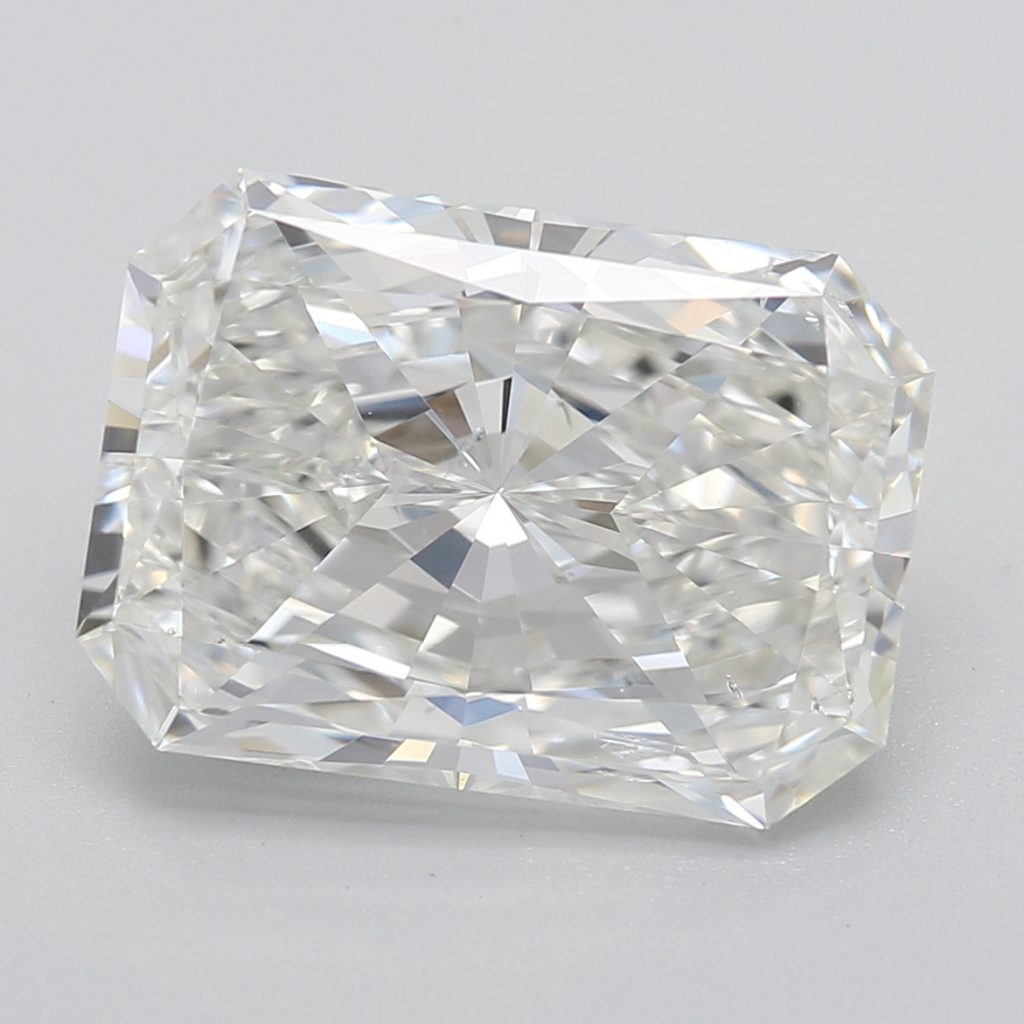
Radiant Cut vs the Emerald Cut
If you’re interested in keeping a high level of sparkle, then the Radiant is by far the best choice. If you’re looking for something a little different – but still highly sophisticated – then we’d recommend the Emerald, provided you don’t mind the loss of scintillation.
There’s no straightforward answer to this. The Emerald offers a fascinating facet pattern, but little sparkle. The Radiant, like the Princess and Cushion, offers a similar sparkle to the Round Brilliant, making it appear a little less unique than the Emerald.
That’s not to say, however, that the Radiant is going to be ‘one of many’. It is sophisticated without looking old-fashioned, and it appears highly luxurious without being extravagant.
The Emerald is prized for its understated, pared-back elegance. The Radiant echoes that same elegance, but with the addition of the fire and brilliance, so many of us can’t say no to it.
Radiant Engagement Rings: Key Factors to Consider
Liking the cut is one thing – knowing how to transform it into the engagement ring of her dreams is another thing entirely.
The Square vs the Rectangle
One thing to look out for in elongated shapes, including the rectangle, is the risk of an area of reduced light, known as a ‘bow tie effect’.
The bow tie effect is commonly seen in Pear, Marquise and Oval diamonds, but the combination of a brilliant facet pattern and the rectangular dimensions of the Radiant make it a distinct possibility. Some bow ties are minor enough that they do not impact the beauty of the diamond, and merely create a sense of depth within the stone, while others will create unmissable dark spots clearly visible through the stone’s table, and ruin its appearance.
The Popularity of the Radiant Cut
It’s not one of the most popular shapes and falls behind the Round Brilliant, Oval and Princess in terms of popularity, but the beauty of this cut means that it’s unlikely to ever fall out of style.
Some shapes, like the Pear and Heart, enjoy temporary stints of popularity before they are no long considered to be the height of fashion. Others, like the Emerald and, you guessed it, the Radiant tend to consistently fall behind other shapes in terms of popularity but never fall out of favor.
This makes it a great choice for many reasons. First of all, using a Radiant cut diamond, even a pretty simple design, will create a ring that is much more unique than it would be if it featured a Round Brilliant or Oval cut diamond. Look at this simple and elegant Radiant Cut Cathedral Engagement Ring, and how the more modern design of the Radiant breathes new life into this traditional shape.
For another, you never need to worry about the Radiant falling out of favor. It’s earned its place among many brides-to-be, and will continue to offer a tempting choice to many shoppers.
It’s all about personal preference, and whether you prefer to go for the true classic, or for a modern classic capable of creating something that bit more original. Popularity is one thing, but timeless beauty is what matters more in the end.
Radiant Diamonds and Color
The Radiant doesn’t mask color as effectively as some other shapes, although you won’t need to shop from the very highest GIA color grades just to ensure that your diamond is free from color.
As in any diamond shape, smaller Radiant cut diamonds are better at masking a small amount of color than larger Radiants. When it comes to finding a center stone, we would generally recommend that our readers focus on the higher end of the Near Colorless category, which runs from G through H, I and J.
Doing so will still stand to save you a significant amount of money – and, even if you’re shopping for a larger carat weight, you can rest assured that your diamond won’t look yellow if you stick to G and H color diamonds.
Radiant Cut Diamond Durability
Due to its beveled corners the Radiant is one of the most durable cuts out there.
Despite the natural strength of diamond, some popular diamond shapes are made more vulnerable to damage by their sharp points or corners. The Princess cut, Pear cut, Heart and Marquise all feature vulnerable spots that can snag, break – or even chip while the jeweler attempts to set the diamond within the ring.
The Radiant is much easier to secure, and much less prone to breakage.
What the Radiant Says About its Wearer
The Radiant cut is favored by brides who are both traditional and out there. It’s a cut that exemplifies the brilliant beauty of diamond, and the elegance of a more understated shape.
If you’re leaning towards this cut, you’re probably outgoing yet sophisticated, vibrant yet refined, and totally committed to more than one side of your personality. It’s a beautiful diamond to showcase a beautiful love story and a great way of representing someone with a taste for two totally different sides of life.
Radiant Diamond Cost
While it may seem like the complexity and versatility of the Radiant cut will be accompanied by a fittingly high cost, it’s possible to get this particular diamond shape at an excellent price. Here’s what you need to know.
Why the Radiant Cut is More Affordable
The Radiant is actually one of the most affordable cuts on the market today, largely as a result of the fact that cutting this shape generates much less wastage than cutting, say, a Round Brilliant.
Due to their coveted sparkle, however, Radiant cut diamonds are significantly more expensive than Emerald cuts. Then again, the Emerald requires shoppers to opt for a higher clarity grade, due to the fact that the shape’s facets are much less effective at concealing minor inclusions, and this is an area where shoppers looking for Radiant cuts can save a large portion of money.
The Cost of a 1 Carat Radiant Diamond
Typically between $2,500 and $8,000, depending on quality.
One of the things shoppers have to get used to very quickly when they start searching for a diamond is the fact that price is determined based on a wide range of factors, rather than carat weight alone.
For most shoppers, carat weight represents the most important feature – alongside sparkle, of course. Still, in order to make sure your diamond lives up to expectations and sparkles as it should, you’ve got to make sure you’re budgeting enough to buy a diamond with a high cut grade (Very Good or Excellent), an eye clean clarity grade, a near colorless grade for color, and no noticeable fluorescence.
This is why we wouldn’t recommend you consider the lower price point of $2,500 to be an opportunity for a great deal. These diamonds will be lacking in quality, and are likely to disappoint.
The Cost of a 2 Carat Radiant Diamond
Between $8,000 and $25,000, but potentially thousands of dollars more in the case of incredibly high quality.
Larger diamonds will always cost significantly more than diamonds half their size, so don’t expect to be able to bag a beautiful 2 carat diamond simply by doubling up on your investment into a 1 carat diamond.
But, at the same time, you also don’t need to worry about aiming for the very highest grades for quality. You can expect to spend around the $17,000 – $18,000 mark for an H color VS2 2 carat Radiant cut diamond, without having to settle for a stone with noticeable imperfections.
Mastering the Art of Choosing a Radiant Cut Diamond
The rectangular radiant cut is a great option for those who like the shape of an emerald cut, but are looking for something with more brilliance.
Choosing a Radiant cut setting is a personal choice, but there are settings that work especially well with the cut. A solitaire setting, especially with prongs, looks stunning with the Radiant cut – like this beautiful Solitaire Radiant Engagement Ring in Yellow Gold. However, it also makes for a stunning piece with a diamond halo, like this Platinum Engagement Ring featuring a Radiant Cut Halo.
As always, the most important thing to do before you invest any money into your chosen diamond is to ensure you are buying from a reputable online store. At WillYou.com, we ensure that you won’t get any nasty surprises – like bow ties, for instance – and every diamond is hand-checked by an expert. As an example, take a look at some of our diamond options here. Nevertheless, even with this knowledge and security, it’s always good to head to our store knowing the basics.
Radiant cut diamond – square vs rectangular
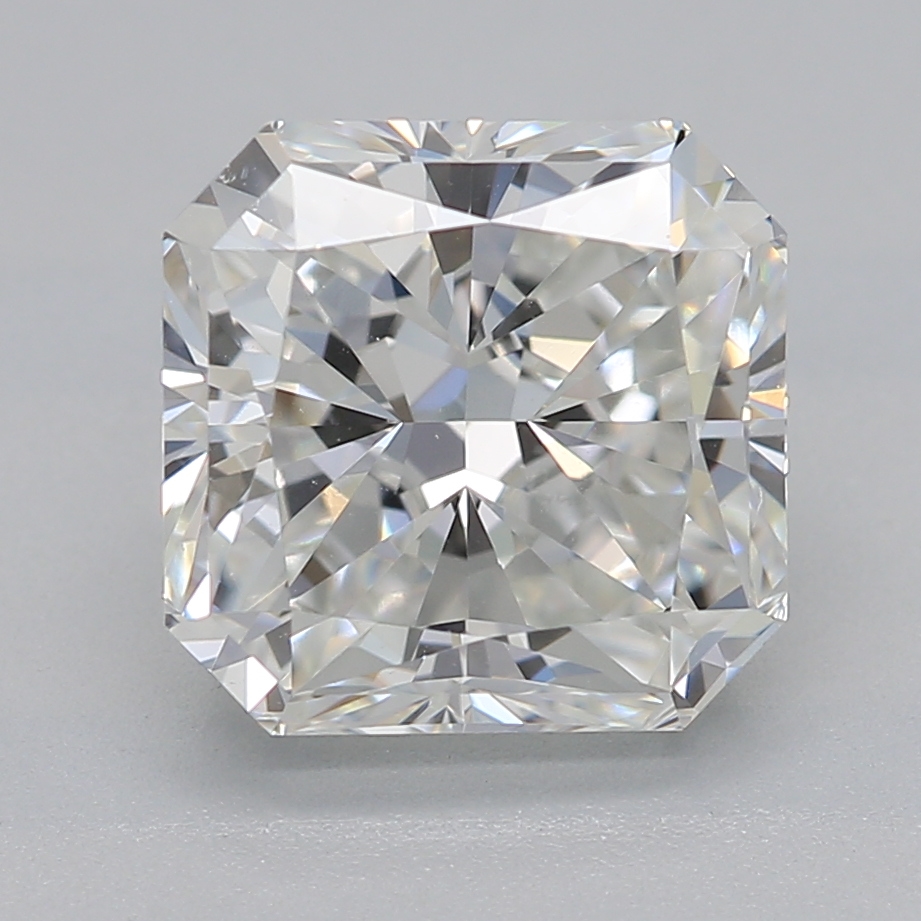
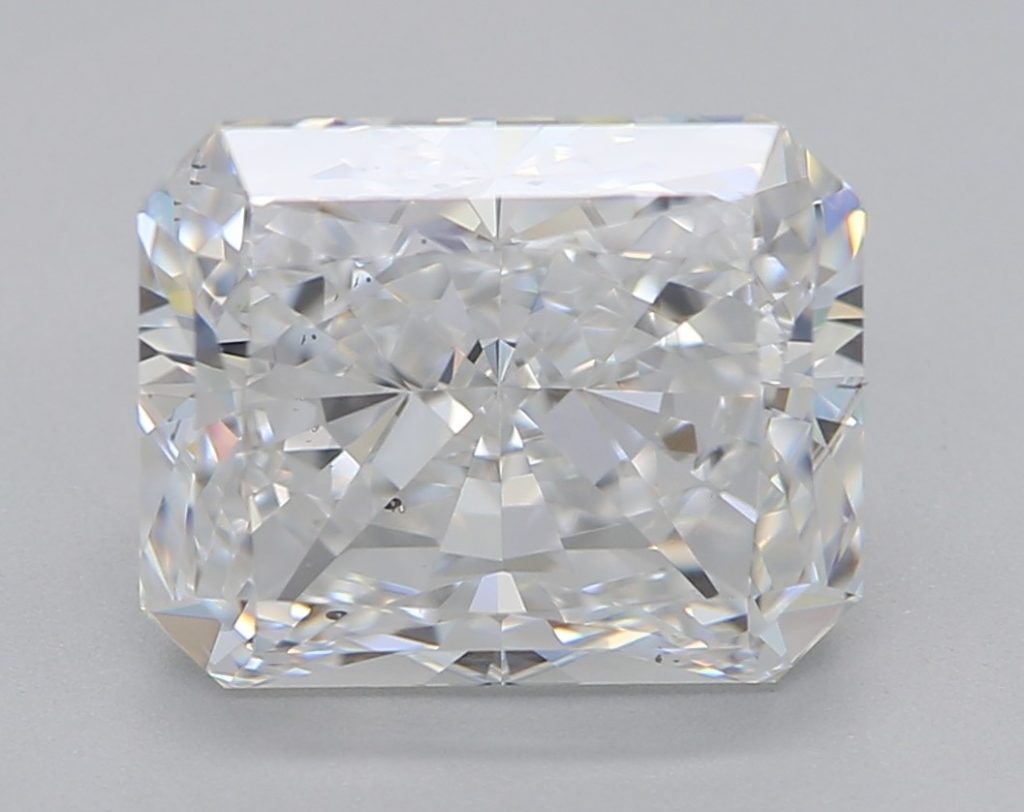
Square Radiant Cut Diamond Size Chart
A Radiant cut diamond has an approximate millimeter size corresponding to its weight in carats. See the chart below for size examples.
| 0.25 ct. | 0.5 ct. | 0.75 ct. | 1.00 ct. | 1.50 ct. | 2.00 ct. | 3.00 ct. | 4.00 ct. | 5.00 ct. |
| 3.5 x 3mm | 5 x 4.5 mm | 5.5 x 5 mm | 6 x 5.5 mm | 7 x 6 mm | 7.5 x 7 mm | 8.5 x 7.5 mm | 9.5 x 8.5 mm | 10 x 9 mm |
The following cut, color and clarity guides should be taken into consideration when choosing a Radiant cut diamond:
Radiant Cut Diamond Length-to-Width Guide
A classic Rectangular Radiant has a length-to-width ratio between 1.22 – 1.32 and a Square Radiant classic length-to-width ratio is 1.00 – 1.029.
| Excellent | Very Good | Good | Fair | Poor | |
| Square | 1.00 – 1.029 | 1.03 – 1.039 | 1.04 – 1.05 | 1.06 – 1.08 | > 1.09 |
| Rectangular | 1.22 – 1.32 | 1.15 – 1.21 or 1.33 – 1.39 | 1.10 – 1.14 or 1.40 – 1.45 | 1.08 – 1.09 or 1.46 – 1.50 | <1.08 or >1.50 |
Square Radiant Cut Diamond Guide – Cut
| Excellent | Very Good | Good | Fair | Poor | |
| Table % | 61 – 69.9 | 57 – 60.9 or 70 – 72.9 | 54 – 56.9 or 73 – 74.9 | 51 – 53.9 or 75 – 79.9 | <50.9 or >80 |
| Depth % | 61 – 67.9 | 59 – 60.9 or 68 – 69.9 | 57 – 58.9 or 70 – 73.9 | 54 – 56.9 or 74 – 79.9 | <53.9 or 80 |
| Girdle | Very Thin or Slightly Thick | Very Thin or Thick | Very Thin or Very Thick | Extremely Thin or Extremely Thick | |
| Culet | None | Very Small | Small | Medium | >Large |
Radiant Cut Diamond Symmetry, Polish, Cut and Fluorescence Guide
Our experience suggests that Cut, Symmetry, Polish, and Fluorescence contribute to a diamond’s brilliance so most buyers will choose Excellent – Very Good and Fluorescence None – Faint.
| Excellent | Very Good | Good | Fair | Poor | |
| Cut | Excellent | Very Good | Good | Fair – Poor | |
| Polish | Excellent | Very Good | Good | Fair – Poor | |
| Symmetry | Excellent | Very Good | Good | Fair – Poor | |
| Fluorescence | None | Faint | Medium | Strong – Very Strong |
Square Radiant Cut Diamond Color Guide
Most buyers prefer size over color hue and will buy a diamond of G color.
| Excellent | Very Good | Good | Fair | Poor | |
| < 0.50 ct. | FL – VS2 | SI1- SI2 | I1 | I2 | > I2 |
| 0.51 – 1.00 ct. | FL – VS1 | VS2 – SI1 | SI2 | I1 – I2 | > I2 |
| 1.00 – 2.00 ct. | FL – VS1 | VS2 – SI1 | SI2 | I1 | > I1 |
| > 2.00 ct. | FL – VS1 | VS2 – SI1 | SI2 | I1 | > I1 |
Rectangular Radiant Cut Diamond Guide – Cut
| Excellent | Very Good | Good | Fair | Poor | |
| Table % | 60 – 66.9 | 58 – 59.9 or 67 – 70.9 | 54 – 57.9 or 71 – 74.9 | 51 – 53.9 or 75 – 79.9 | <50.9 or >80 |
| Depth % | 63 – 67.9 | 59 – 62.9 or 68 – 69.9 | 57 – 58.9 or 70 – 74.9 | 54 – 56.9 or 75 – 79.9 | <53.9 or 80 |
| Girdle | Very Thin or Slightly Thick | Very Thin or Thick | Very Thin or Very Thick | Extremely Thin or Extremely Thick | |
| Culet | None | Very Small | Small | Medium | > Large |
Rectangular Radiant Cut Diamond Color Guide
Most buyers prefer size over color hue and will buy a diamond of G color.
| Excellent | Very Good | Good | Fair | Poor | |
| < 0.50 ct. | D – G | H – I | J – K | L – M | > N |
| 0.51 – 1.00 ct. | D – F | G – H | I – J | K | > L |
| 1.00 – 2.00 ct. | D – F | G – H | I – J | K | > J |
| > 2.00 ct. | D – F | G – H | I – J | K | > J |
Rectangular Radiant Cut Diamond Symmetry, Polish, Cut and Fluorescence Guide
| Excellent | Very Good | Good | Fair | Poor | |
| Cut | Excellent | Very Good | Good | Fair – Poor | |
| Polish | Excellent | Very Good | Good | Fair – Poor | |
| Symmetry | Excellent | Very Good | Good | Fair – Poor | |
| Fluorescence | None | Faint | Medium | Strong – Very Strong |
Rectangular Radiant Cut Diamond Clarity Guide
Most buyers prefer size over clarity cleanse and will buy a diamond of VS2 – SI1 Clarity.
| Excellent | Very Good | Good | Fair | Poor | |
| < 0.50 ct. | FL – VS2 | SI1- SI2 | I1 | I2 | > I2 |
| 0.51 – 1.00 ct. | FL – VS1 | VS2 – SI1 | SI2 | I1 – I2 | > I2 |
| 1.00 – 2.00 ct. | FL – VS1 | VS2 – SI1 | SI2 | I1 | > I1 |
| > 2.00 ct. | FL – VS1 | VS2 – SI1 | SI2 | I1 | > I1 |
Radiant Cut Diamond Pros and Cons
There are pros and cons with every type of cut, including the Radiant cut.
Pros
The most obvious pro is, of course, that the Radiant offers a more unique hybrid of two very different cuts – cuts that sit on opposite ends of the spectrum in terms of sparkle and shape. More than a compromise between the two, the Radiant offers something totally new, modern, and stunning for elegant brides.
Another advantage of the Radiant cut is that it hides the blemishes of the stone better than most cuts. The Radiant has a special talent in hiding them. It is also very versatile, allowing for the cut to pair well with almost any style.
Cons
A disadvantage of the Radiant is its bow-tie effect. With more rectangular cuts, the Radiant shape can produce an area of reduced color in the center of the gem, resembling a bow tie. At WillYou, however, we only ever select diamonds that feature no significant bow tie on behalf of our customers.
Our Expert Take
The Radiant is a great alternative to the Emerald. Why? Because the Emerald cut tends to divide opinion when it comes to engagement rings. A beautiful and chic cut, its lack of sparkle is a dealbreaker for many brides looking to maximize the features that diamonds are most famous for: brilliance, fire, and scintillation.
The Radiant offers a great middle ground between the brilliant cuts and the Emerald – but, more than that, it offers a beautiful and unique center piece for the modern bride’s engagement ring. Strong, bold, timeless, and vibrant, the Radiant is one of the most compelling options for anyone looking at diamonds today.
If you’re interested in this shape, then take a look at our range of GIA certified Radiant cut diamonds here.
7 FAQs
- Q: What Makes a Radiant Cut Diamond Unique?
- A: A radiant cut diamond is known for its hybrid shape, combining the brilliance of a round cut and the clean lines of an emerald cut. It has 70 facets, offering exceptional sparkle and a distinctive silhouette.
- Q: How Do I Choose the Best Length-to-Width Ratio for a Radiant Cut Diamond?
- A: For a classic rectangular shape, opt for a ratio of 1.25, while a square radiant cut looks best with a ratio close to 1.00. The choice depends on personal preference for a more elongated or squared appearance.
- Q: What is the Bow-Tie Effect in Radiant Cut Diamonds?
- A: The bow-tie effect is a visible dark area across the center of the diamond. It varies in intensity and can add depth or detract from the stone’s beauty, depending on its prominence.
- Q: How Important are Color and Clarity in Radiant Cut Diamonds?
- A: While radiant cuts can mask some imperfections and slight coloration, it’s wise to choose a diamond with a color grade of G-H and clarity of VS1-SI1 for a balance of quality and value.
- Q: What Are the Best Settings for Radiant Cut Diamonds?
- A: Solitaire, halo, and side stone settings are popular choices. The setting should secure the diamond well and complement its unique shape and sparkle.
- Q: How Do Radiant Cut Diamonds Compare in Price to Other Shapes?
- A: Radiant cut diamonds generally offer a good balance of size and brilliance at a relatively affordable price, often being less expensive than round brilliants of similar size and quality.
- Q: Can Radiant Cut Diamonds Hide Inclusions and Color Well?
- A: Yes, due to their faceting pattern, radiant cut diamonds can hide inclusions and some color variations better than other cuts like emerald or asscher cuts.
Discover the perfect radiant cut diamond with Jeweler AI – your personalized guide to finding the ideal engagement ring with ease and precision.
FOLLOW-UP GUIDE SERIES

